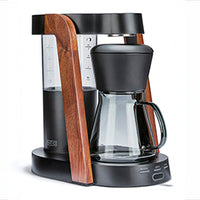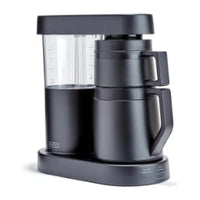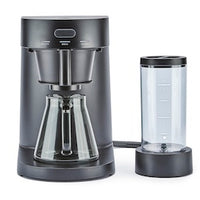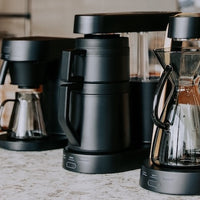Your “Clean” Carafe Might Be Holding on to Old Flavors
Key Takeaways
-
Coffee oils cling to carafe surfaces and degrade over time, affecting flavor
-
Regular rinsing isn’t enough — deep cleaning is needed to remove buildup
-
Stale residue can add bitterness or musty notes to fresh brews
-
Glass and stainless steel carafes each require different cleaning approaches
-
A truly clean carafe preserves clarity and consistency in your coffee
You might rinse your carafe every morning and think you’re in the clear. But if your coffee suddenly tastes “off,” there’s a good chance your so-called clean carafe is the problem.
Coffee leaves behind more than color. Oils, tannins, and microscopic residues stick to the walls of your carafe — especially in hard-to-reach spots like corners or spouts. These residues build up over time, and even a spotless-looking vessel can harbor stale flavors.
Let’s talk about why your carafe needs more attention and how to clean it the right way for better-tasting coffee every time.
Why Rinsing Isn’t Enough
A quick rinse might remove visible coffee stains, but it doesn’t address what’s really lingering:
-
Coffee oils that cling to surfaces and go rancid over time
-
Mineral buildup from water deposits, especially with hard water
-
Bacterial growth in humid environments (like under the lid)
-
Old residue that taints new brews with stale or sour flavors
These elements subtly distort your coffee’s natural flavor. That sweet, fruity note in your beans? Muted. The round body? Replaced with a weird chalkiness. It’s death by a thousand sips.
What Residue Really Does to Flavor
Old coffee oils oxidize. As they break down, they introduce flavors that clash with fresh coffee:
-
Bitterness that wasn’t there before
-
Sour, metallic, or papery notes
-
Muted aromatics
-
Residual aftertaste that clings to the tongue
These issues don’t always appear overnight — they creep in gradually, which is why so many home brewers don’t notice until the difference is drastic.
Glass vs Stainless Steel: What You’re Dealing With
Your carafe’s material affects how easily residue clings — and how you should clean it.
Glass Carafes:
-
Tend to show stains and discoloration more clearly
-
Easier to inspect visually
-
Can be scrubbed gently with brushes or baking soda
Stainless Steel Carafes:
-
Hide stains well, but that doesn’t mean they’re clean
-
Harder to inspect inside due to narrow openings
-
Require regular deep soaks and odor removal
Both types need more than a rinse. If you’re using a thermal carafe, pay extra attention — the sealed environment can trap moisture and odor more easily.

How to Deep Clean Your Carafe (Properly)
The key is removing both visible residue and invisible oil film. Here’s how:
For Glass Carafes:
-
Fill with warm water and a tablespoon of baking soda
-
Add a splash of vinegar for extra lift
-
Let sit for 15–30 minutes
-
Scrub with a soft brush or bottle cleaner
-
Rinse thoroughly, air dry upside down
For Stainless Steel Carafes:
-
Fill with hot water and one tablet of cleaning detergent (or a tablespoon of unscented dish soap + baking soda)
-
Let soak for at least 30 minutes
-
Swirl and scrub with a narrow bottle brush
-
Rinse repeatedly — stainless steel holds onto smell
-
Air dry with the lid off
Optional: Use odor-neutralizing tablets or a lemon/baking soda mix once a week.
Signs Your Carafe Is Affecting Flavor
It’s easy to blame beans or technique. But watch for these red flags:
-
Brew suddenly tastes bitter despite same recipe
-
Unexplained sourness or metallic notes
-
Coffee cools and reveals odd flavors
-
No improvement even after changing grind or beans
If any of these sound familiar, deep-clean your carafe and test the same brew again. You might be surprised how much fresher it tastes.
Other Common Culprits to Clean With Your Carafe
Your carafe is part of a system — if one element is dirty, it can spoil the whole brew. Don’t forget:
-
Brewer showerhead — often clogged with oils and residue
-
Lid and spout — hard to reach but easy to foul
-
Filter basket — traps old grounds and oils
A clean carafe only helps if the rest of your gear gets similar treatment.
How Often Should You Deep Clean?
That depends on usage, but as a rule of thumb:
-
Daily use: Deep clean once a week
-
Occasional use: Clean after every few brews
-
After oily or flavored coffee: Clean immediately
If you switch beans or roast styles often, more frequent cleaning will help reset your gear and avoid flavor contamination.
Preserving the Flavor You Paid For
You spend money on quality beans. You pay attention to water, grind, and timing. Don’t let an overlooked carafe dull all that effort.
Even the most thoughtfully brewed cup will suffer if it passes through old oils and stale film. A clean carafe ensures that what ends up in your cup reflects the actual character of your coffee.
Subtle Tools Make a Big Difference
Coffee machines like those from Ratio Coffee are known for precision and simplicity — but their performance relies on well-maintained gear. When paired with a truly clean carafe, the resulting brew honors every choice you’ve made along the way.
Clean gear isn’t glamorous. But it’s the hidden backbone of a great cup.
Frequently Asked Questions
Why does my coffee taste worse over time?
It could be residue in your carafe or other equipment. Over time, oils and build-up distort flavor, even if your technique stays the same.
Can I use bleach to clean my carafe?
Not recommended. It can be hard to rinse fully and may affect taste. Use baking soda, vinegar, or coffee-specific cleaners.
How do I clean a carafe with a very narrow opening?
Use a bottle brush designed for baby bottles or specialty cleaning tablets that dissolve and deodorize without scrubbing.
 Ratio Eight S2
Ratio Eight S2
 Ratio Eight Original
Ratio Eight Original
 Ratio Six
Ratio Six
 Ratio Four
Ratio Four
 Compare Machines
Compare Machines






